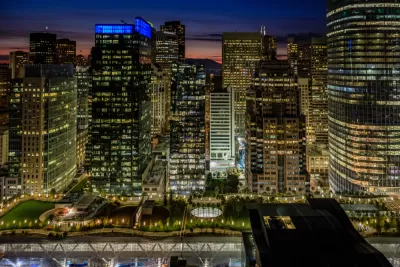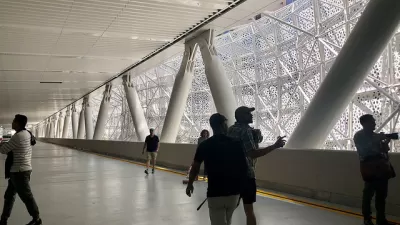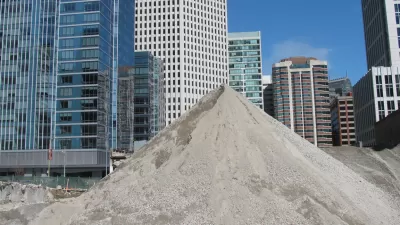The $2.2 billion Salesforce Transit Center, which opened to much celebration on Aug. 11, closed down abruptly Sept. 25 after workers found a cracked steel beam. A second cracked beam was later found. Work began Sunday to shore up the structure.

"The cracked beam was spotted Tuesday morning by workers installing ceiling panels on the center’s third-floor bus platform, and concern over its potential failure prompted city officials to close the terminal and some streets at 4:30 p.m," report for the Chronicle on Sept. 28.
They shunted rush-hour commuters to the nearby Temporary Transbay Terminal, which had been used during the center’s construction.
During an overnight inspection of the center, which opened on Aug. 11, a second crack was discovered, though smaller than "[t]he initial tear [that] runs about 2½ feet long and 4 inches deep through the bottom of a 60-foot-long beam that supports both the center’s celebrated rooftop park above and a bus deck below," reported the Chronicle's and
Representatives of the Transbay Joint Powers Authority, which built and operates the transit center, said Wednesday they didn’t know the causes of the cracks, but they remained concerned about the potential for the beams to fail. Fremont Street, which passes under the center, also is scheduled to stay closed through Oct. 5.
The Chronicle's urban design critic, John King, delves into the structural engineering aspects of the three-block, 1,500-foot building that "twice span major roadways."
Those spans are supported by just four massive beams. Two of them have cracked.
What makes the situation so worrisome is that the cracked girders are the primary means of support for the transit center as it spans Fremont. The only things below the bus deck are sidewalks and asphalt.
King interviewed many structural engineers for the story.
“You’ve got a bus deck hanging from a column that in turn is held up by two cracked beams,” said Joe Maffei, founder of San Francisco’s Maffei Structural Engineering...“I think we are lucky that there was not a collapse.”
While it is not known what caused the cracking of the steel beams which were fabricated by Herrick Corp. in Stockton, Calif., King offers one possiblity:
The most troubling scenario is that the design by Thornton Tomassetti structural engineers and Pelli Clark Pelli Architects didn’t adequately account for the twin pressures of a bus deck and rooftop.
"Hydraulic jacks and newly fabricated steel beams arrived Sunday morning ... where they’ll be used to shore up the spot over Fremont Street where cracks were discovered," reports Michael Cabanatuan on Sept. 30.
By midnight Sunday, Mark Zabaneh, director for the Transbay Joint Powers Authority, said the first of three phases of shoring up the transit center should be completed. It’s not yet clear how long the whole process will take, but by Monday or Tuesday, he said, authorities should have a better idea of when they can partially open Fremont Street.
Once crews install the temporary bracing, it will relieve weight from the damaged girders and allow extensive testing to help determine the cause of the cracking. It could take a week or longer to get results of those tests, he said.
Matier and Ross note the proximity of the transit center to two other engineering failures:
- The center sits next to the troubled Millennium Tower, which has sunk 18 inches since it opened in 2009.
- The cracked beam is also reminiscent of the cracked bolts that plagued the eastern span of the Bay Bridge.
Related in Planetizen
-
San Francisco's Transbay Transit Center Opens This Weekend, August 8, 2018
FULL STORY: It looks simple, but it’s not. Complexity of Transbay Transit Center raises risks

Planetizen Federal Action Tracker
A weekly monitor of how Trump’s orders and actions are impacting planners and planning in America.

Congressman Proposes Bill to Rename DC Metro “Trump Train”
The Make Autorail Great Again Act would withhold federal funding to the system until the Washington Metropolitan Area Transit Authority (WMATA), rebrands as the Washington Metropolitan Authority for Greater Access (WMAGA).

DARTSpace Platform Streamlines Dallas TOD Application Process
The Dallas transit agency hopes a shorter permitting timeline will boost transit-oriented development around rail stations.

San Francisco's School District Spent $105M To Build Affordable Housing for Teachers — And That's Just the Beginning
SFUSD joins a growing list of school districts using their land holdings to address housing affordability challenges faced by their own employees.

Car-Centric LA Suburb Looks to a Train-Oriented Future
City leaders in Rancho Cucamonga, the future western terminus of the Brightline West rail line to Las Vegas, want to reimagine the city as a transit-oriented, pedestrian-friendly community.

New Alaska Bitcoin Mine Would Burn as Much Energy as the State’s Largest Coal Plant
Fueled by “stranded” natural gas, the startup hopes to become the largest in the US, and to make Alaska an industry center.
Urban Design for Planners 1: Software Tools
This six-course series explores essential urban design concepts using open source software and equips planners with the tools they need to participate fully in the urban design process.
Planning for Universal Design
Learn the tools for implementing Universal Design in planning regulations.
Municipality of Princeton
Roanoke Valley-Alleghany Regional Commission
City of Mt Shasta
City of Camden Redevelopment Agency
City of Astoria
Transportation Research & Education Center (TREC) at Portland State University
US High Speed Rail Association
City of Camden Redevelopment Agency
Municipality of Princeton (NJ)





























